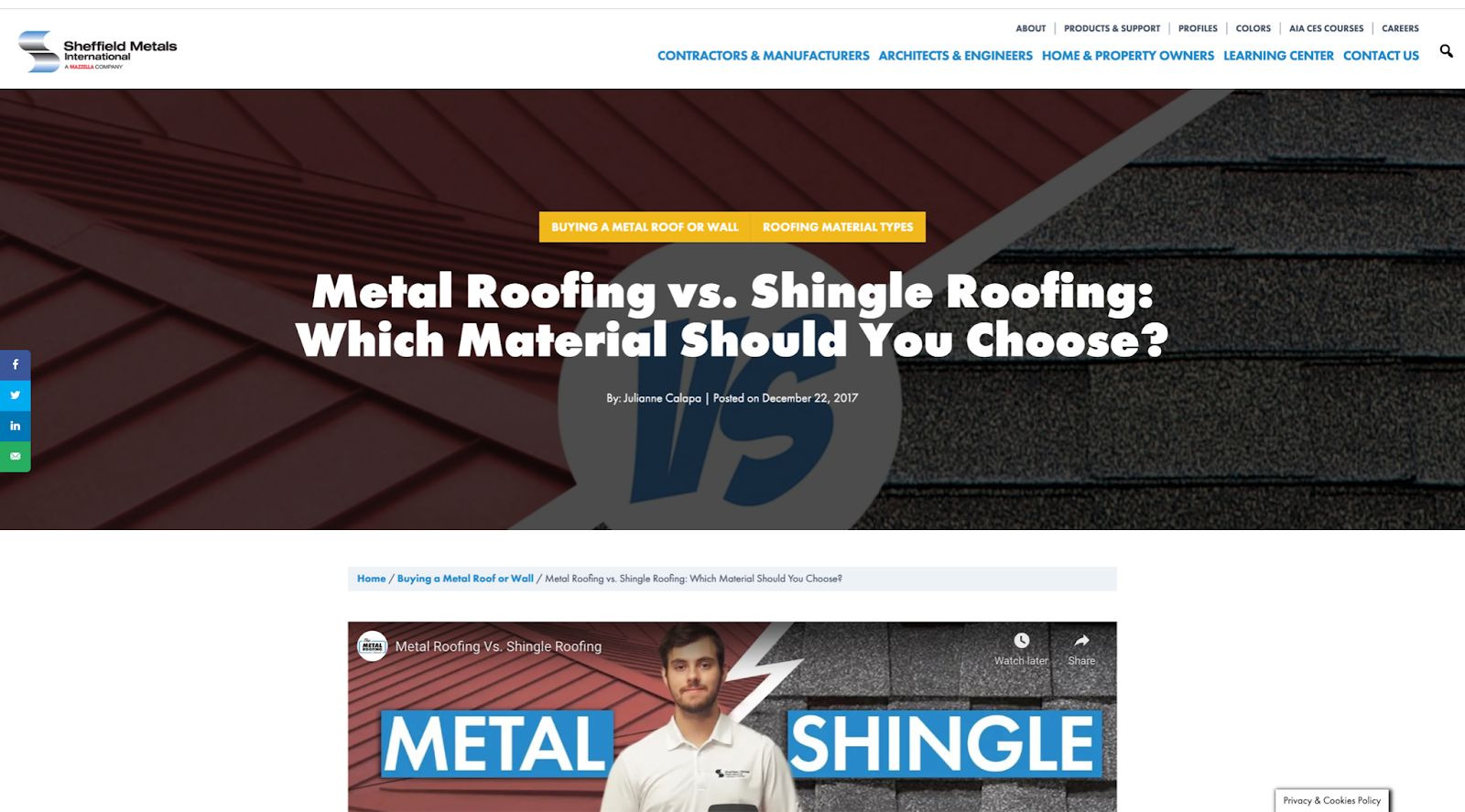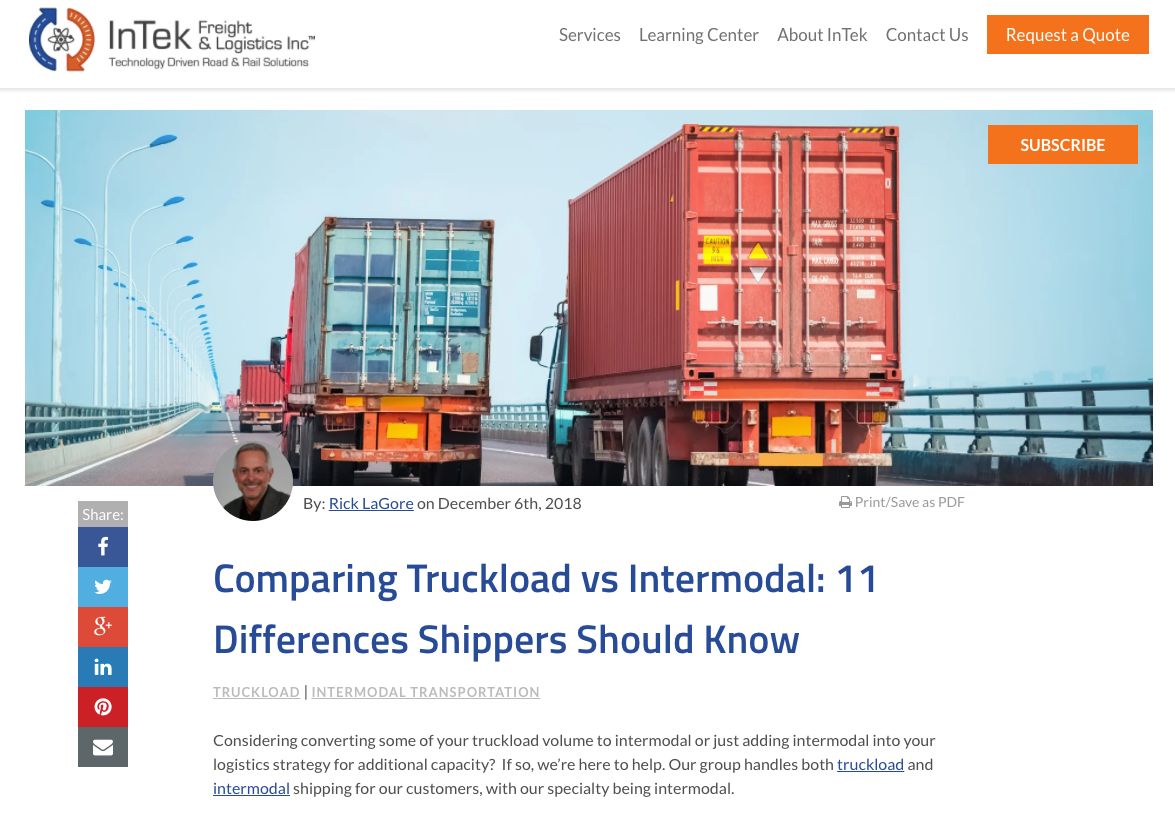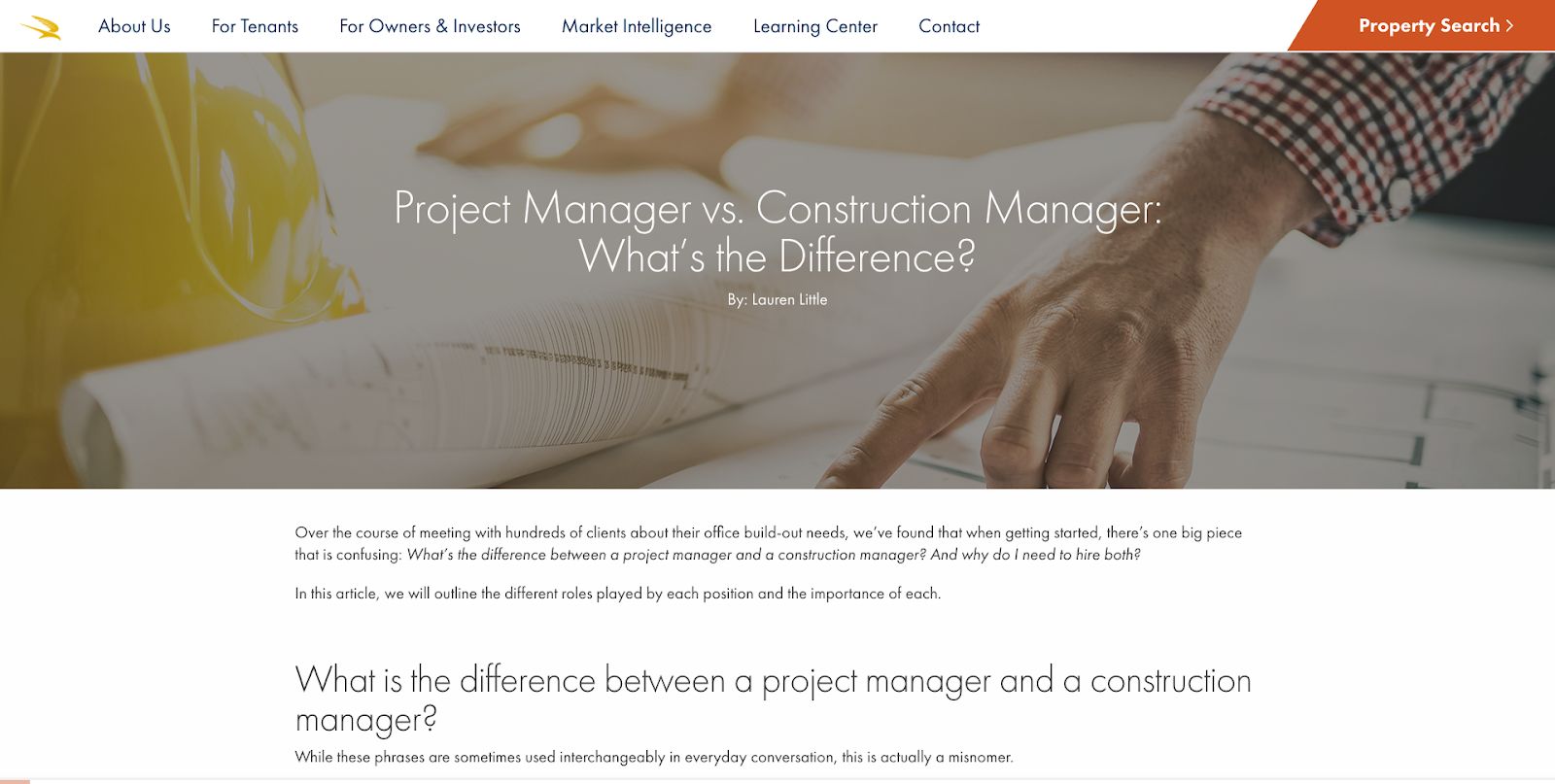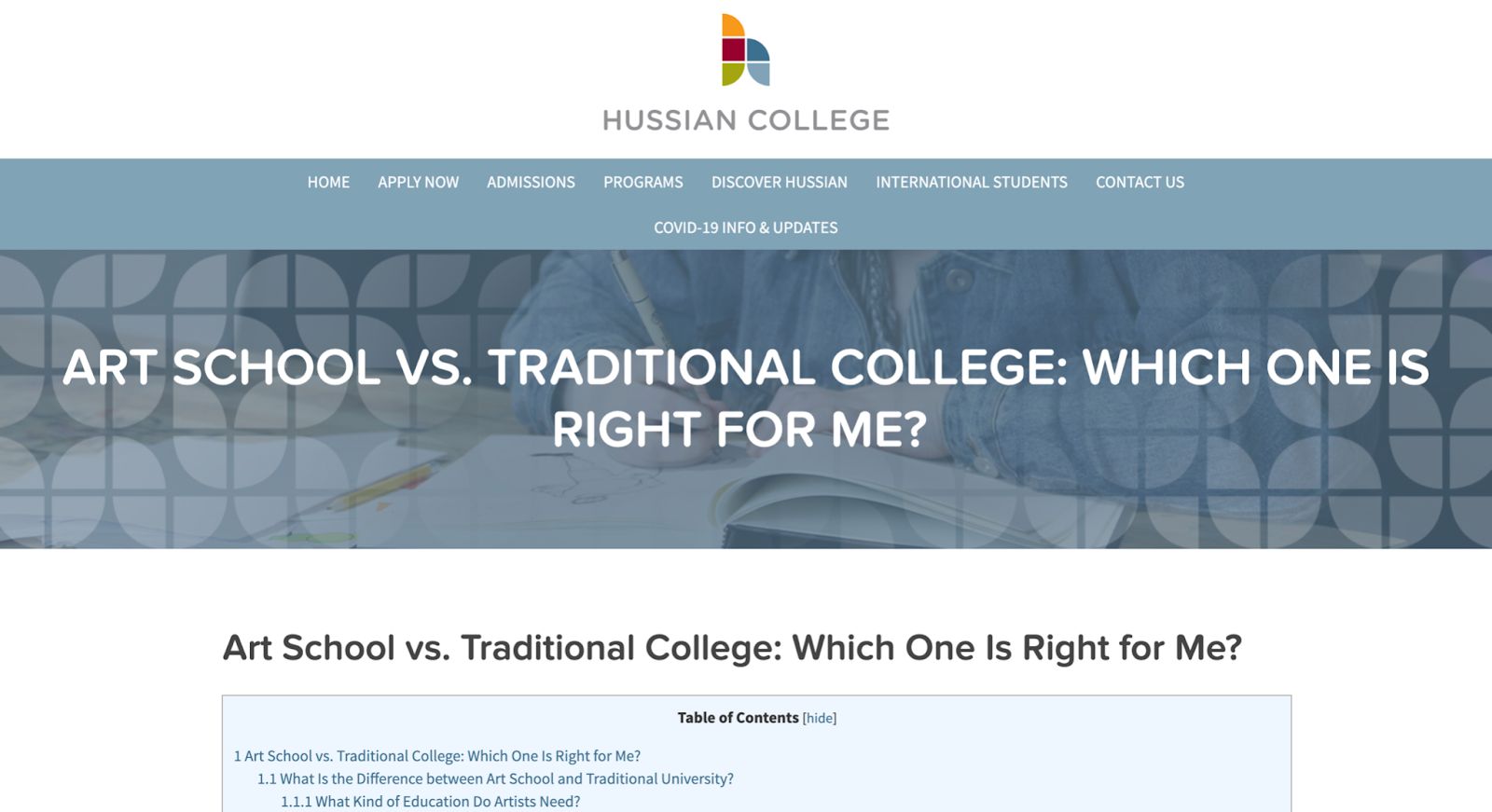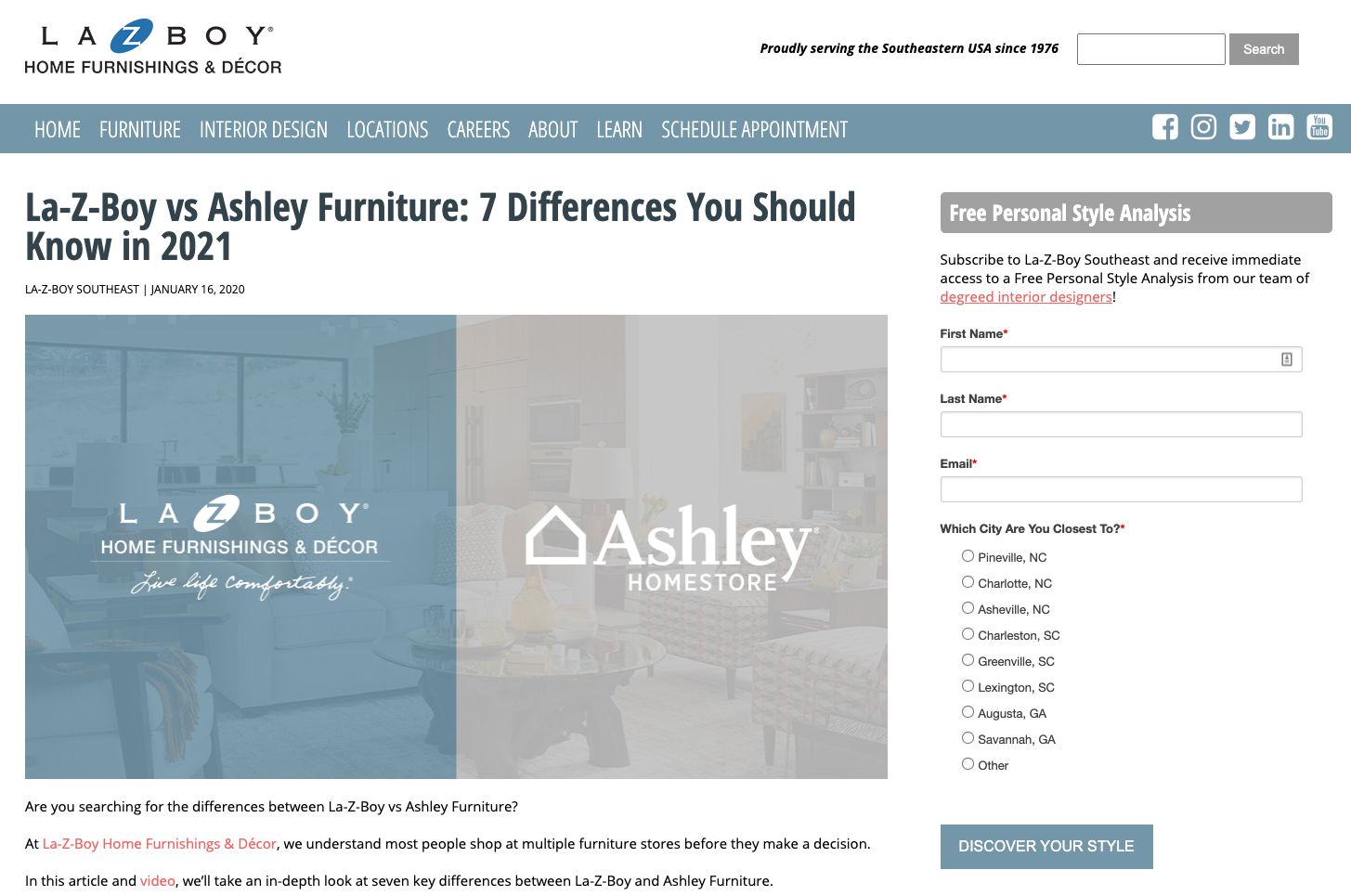18 Great Examples of Comparison Blog Articles and Content
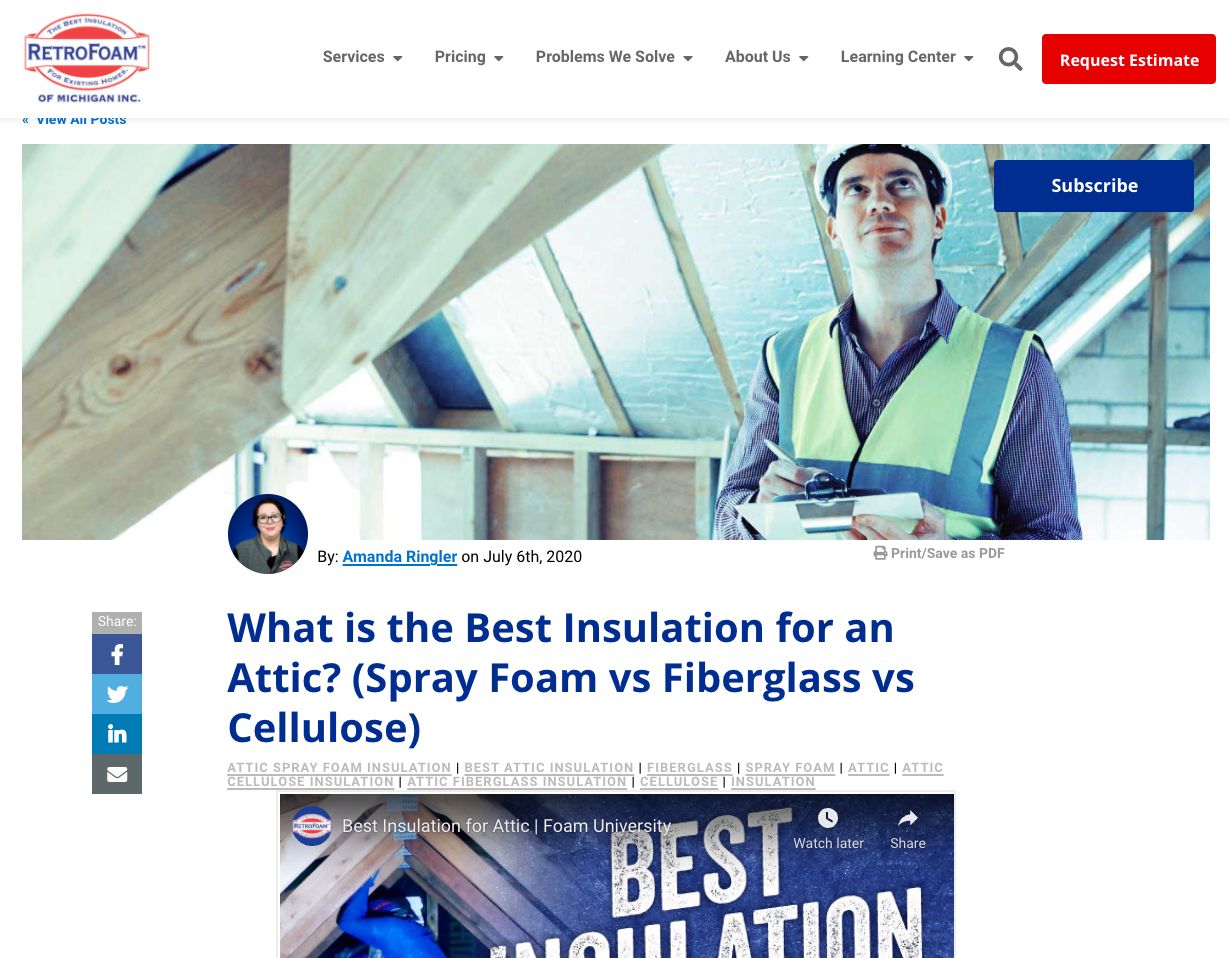
Table of Contents
If there’s one thing modern consumers have too much of it’s options.
Whether it’s what store to shop at, which smartphone to buy, which roofing company to hire, or even what business methodology to follow, there are a plethora of options and alternatives at our fingertips and it’s difficult to decide amongst them.
It’s only natural to want to compare and contrast these options, which makes comparison articles and content such a sought-after and effective piece of a successful content strategy.
Creating comparison content as a business may look like comparing your company to a competitor, contrasting two potential solutions to a common problem faced by your buyer, or even a mix of the two.
Either way, embracing the modern buyer’s need for comparisons will help you get in front of your target audience when they’re weighing their options, guide the conversation surrounding the comparison, and build trust as the expert who provided the answer your buyer was looking for.
Once people understand the problem they’re trying to solve, these educational pieces help them evaluate their options and make their decisions more confidently.
IMPACT has helped thousands of businesses around the world create successful, traffic and lead-driving comparison content. In this article, we will guide you to do the same. We will:
- Explain what comparison articles are
- Discuss how to write comparison articles and content
- Share 18 examples of comparison content done right
Free Guide: The Ultimate Inbound Marketing Strategy Playbook 2022
What are comparison articles?
Comparison articles are articles that directly compare alternative products, services, or solutions to help potential customers understand the differences and similarities and make the best decision possible for their needs — ultimately, avoiding buyers’ remorse.
They are also one of what we call “The Big 5,” which, if you’re a regular around here, are the five content topics that tend to drive the most web traffic and sales and are covered at length in Marcus Sheridan’s book They Ask, You Answer.
I know firsthand how effective these articles can be because, years ago, IMPACT trained me how to write them for one of my own clients.
The articles I wrote using this method quickly climbed the ranks and landed on the first page of Google’s search results, beating out several big-name competitors — multiple times and in several different categories.
My former client’s organic web traffic is still growing and providing about 80% of their leads.
So, we know it works. Let’s look at how to write your own.
How to write comparison articles
The most difficult part for marketers and content creators when tackling comparison articles (and business blog posts in general) is not fully grasping how we should be writing them.
What should we include? How should we structure the article? What does success look like?
You can read “how to write a great comparison article,” to get more detail but in nutshell, great comparison content should accomplish three things:
- Be honest and unbiased
- Provide clear comparison criteria
- Leave the reader understanding which option is right for them
Remember, your comparison content doesn’t have to be limited to just written articles. It can (and frankly I encourage it to) expand to include other mediums like videos, tools, or even website pages.
Examples of great comparison articles and content
If you’re a visual learner like me and need to see concrete samples of successful comparison articles and content out in the wild before you can knock out your own, this article is for you.
I’ve broken them out into four comparison article and content approaches:
- Pro and con comparison articles
- Category comparison articles
- Competitor comparison articles
- Comparison pages, videos, and tools
These cover a range of B2B and B2C products and services.
We hope that by seeing different examples, you’ll find something similar to your business’ offerings.
Pro and con comparison articles
Pro and con comparison articles are where you share all the potential positives and negatives of a product, service, or solution you (or your competitor) provide — as honestly and transparently as possible.
By providing as much objective information as you can, your customers will be educated enough to decide which choice is right for them. This will help your buyers feel more comfortable purchasing from you because they know what to expect.
Here are some articles that do this well:
1. What is the Best Insulation for an Attic? (Spray Foam vs Fiberglass vs Cellulose) — RetroFoam of Michigan
A perfect example of this type of pro and con comparison article is from IMPACT client RetroFoam of Michigan.
In this article, the company explains the pluses and minuses of different home insulation materials. Should you choose spray foam, fiberglass, or cellulose? What’s the difference?
What we like about this article:
- The pros and cons are listed clearly and succinctly as bullet points.
- It’s easy to read and scan to quickly get the information you’re looking for.
- The article is honest about what might go wrong with cellulose insulation, such as potentially leading to higher energy bills or circulating more dust.
The article is helpful, honest, and educational, and after reading it, you should have a better idea of what type of insulation you’d buy for your attic.
2. The difference between formal and informal meetings — Slack
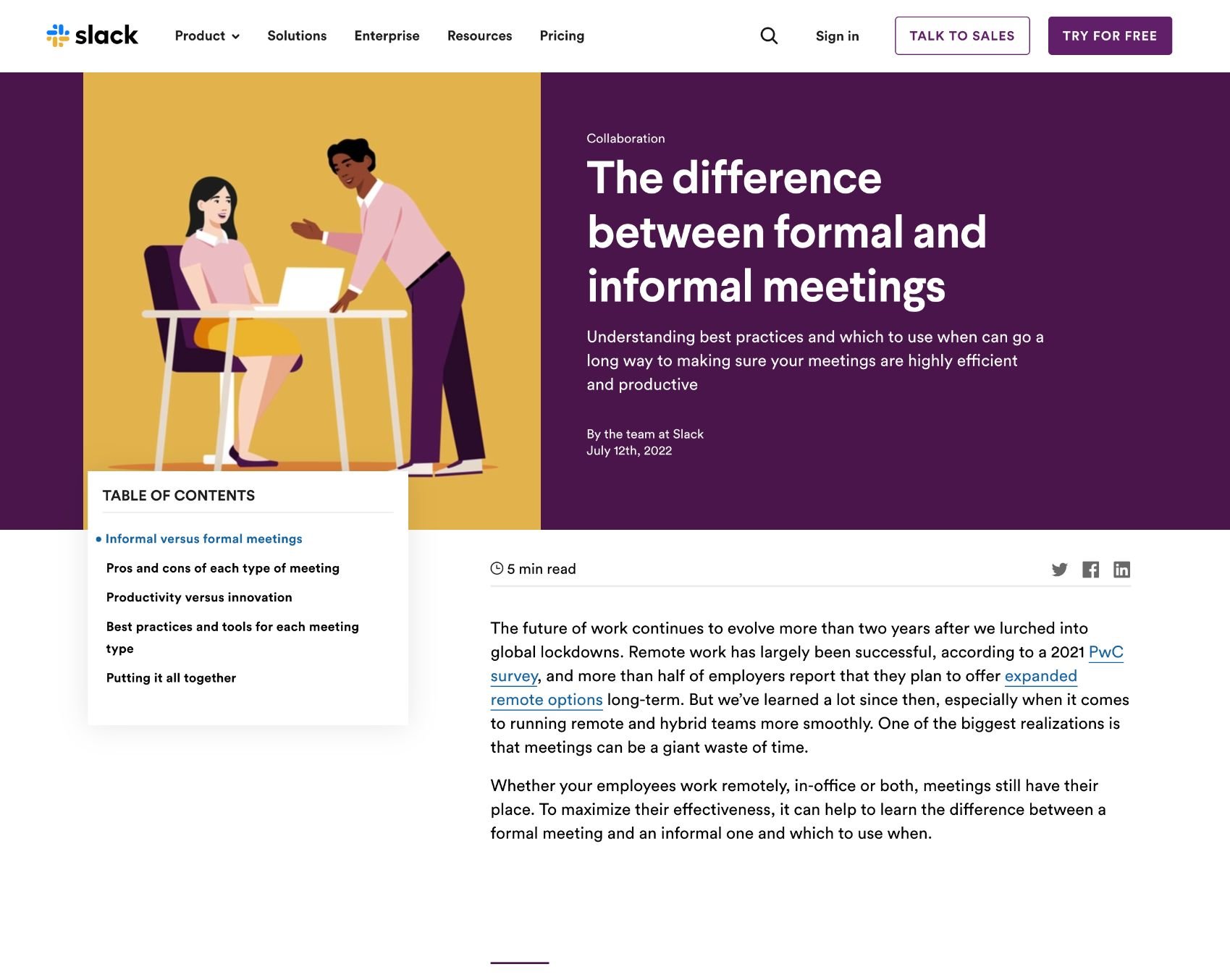
Here, we have a unique comparison article.
Slack is a real-time messaging app that is popular among business teams. Rather than comparing different software offerings, Slack weighs the pros and cons of another relevant area of concern for its buyers — running effective meetings and communication.
The article offers a direct comparison based on common goals of meetings as well as best practices for running each kind.
Overall, the piece leaves you with the information you need to choose the right dynamic for you and, regardless of which option you choose, you’re set up for success.
3. Metal Roofing vs. Shingle Roofing: Which Material Should You Choose? — Sheffield Metals
In this pro and con comparison article, another IMPACT client, Sheffield Metals, shares everything you need to know about the benefits and drawbacks of metal roofing (which they sell) or asphalt shingle roofing (which their competitors sell).
Instead of trying to convince you that metal is the best, they thoroughly lay out all the best and worst characteristics of both options.
What we like about this article:
- Lots of large, clear photos
- Easy-to-digest with scannable bullet points
- In-depth pros and cons
- Helpful calculations detailing the lifecycle of the different options
But the best part is where they conclude that both options are great (even the shingles!), and that it just depends on your needs as the customer.
Don’t we all want to be treated like that as consumers?
4. Inkjet vs Laser Printers: Pros, Cons & Recommendation — Office Interiors
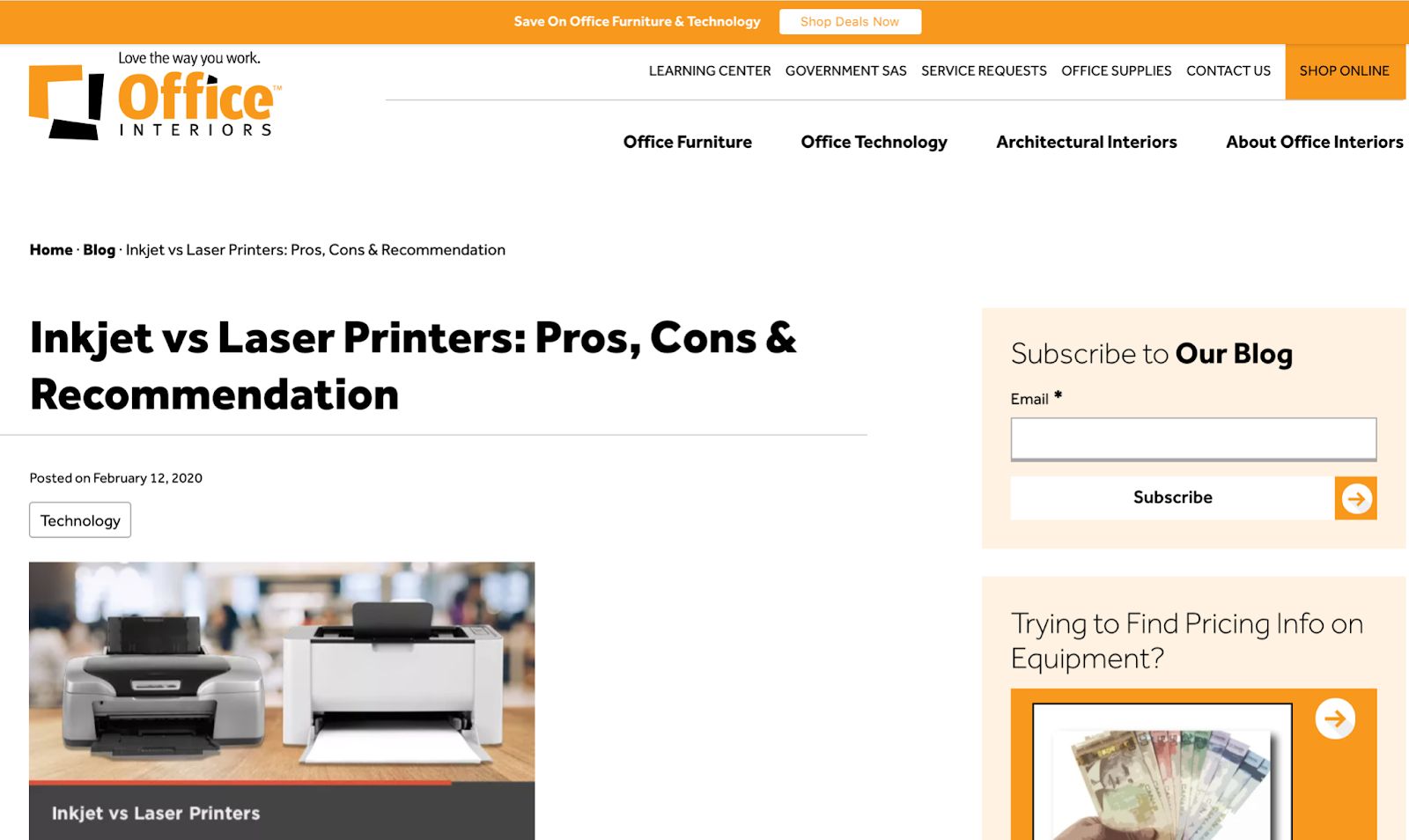
IMPACT client Office Interiors, like its name suggests, sells office furniture and supplies.
It published a pro and con comparison article describing how these printers work differently, which many people might not know. For example, inkjet printers use heat and make higher-quality images, while laser printers are better for text documents.
Who knew?
What we like about this article:
- Bolded main points make the article easy to scan
- A ton of useful information in a shorter article
- Doesn’t shy away from mentioning how one option might not be a good fit
- A video opener explaining the differences with an in-house expert
5. The Pros and Cons of Solar Energy — SunPower
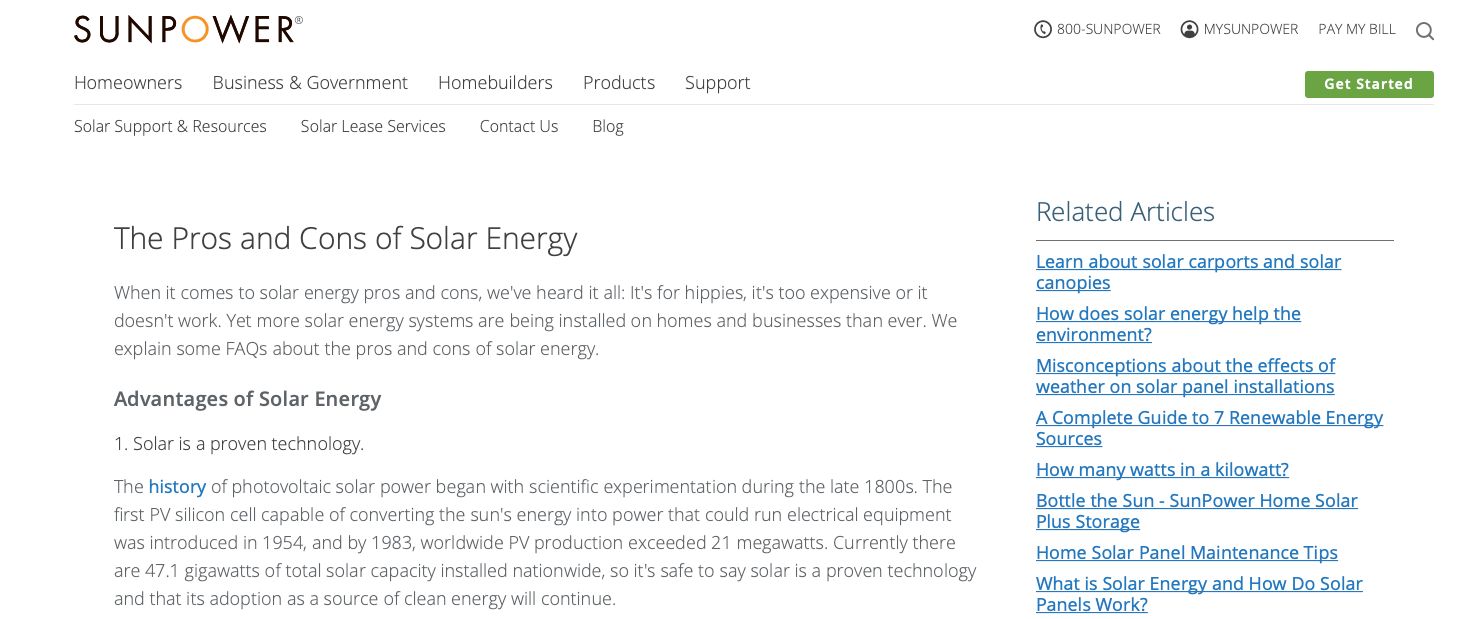
SunPower — a business that sells solar panels and access to green energy — really nails this pros and cons article about its offerings.
They explain all the benefits of having solar energy to power your home but are also honest about the drawbacks, such as the stress of solar panel manufacturing on the environment, installation difficulties, and nighttime limitations.
What we like about this article:
- Even though it’s not fancy to look at, it’s extremely informational
- There’s a related article list where you can learn more about solar energy
- If you’re interested in finding out if your home qualifies, you can fill out a form at the end of the article
6. Insourcing content vs. outsourcing content: Which is better for marketing? — IMPACT
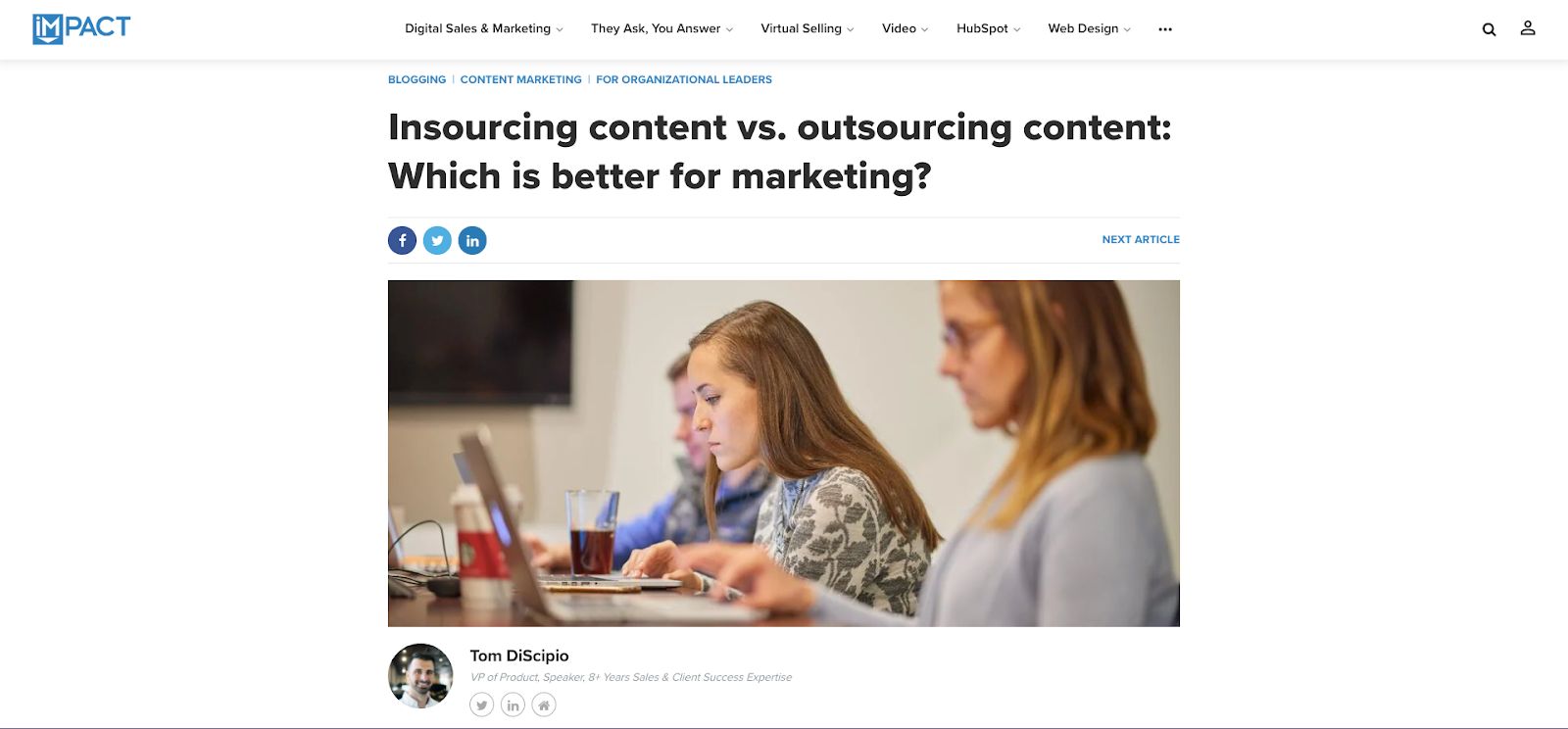
Many people implementing a content marketing program want to know if it’s better to insource or outsource content from an agency. In keeping with the spirit of honesty, this article from our team is upfront about how difficult it can be to make this choice.
(If we were biased, we could say, “Just pick us, the agency that teaches you how to create your content in-house” and call it a day. But remember with comparison articles, honesty is key.)
What we like about this article:
- Clearly states it’s ideal for people implementing a content marketing plan but can also be useful for those in the planning stages
- Introduces content by saying it’s based on years of helping other clients (underlining their experience and reinforcing their authority)
- Mentions people find success with both approaches
Honesty wins again.
7. Paylocity vs. Whirks: What’s the Difference? — Whirks
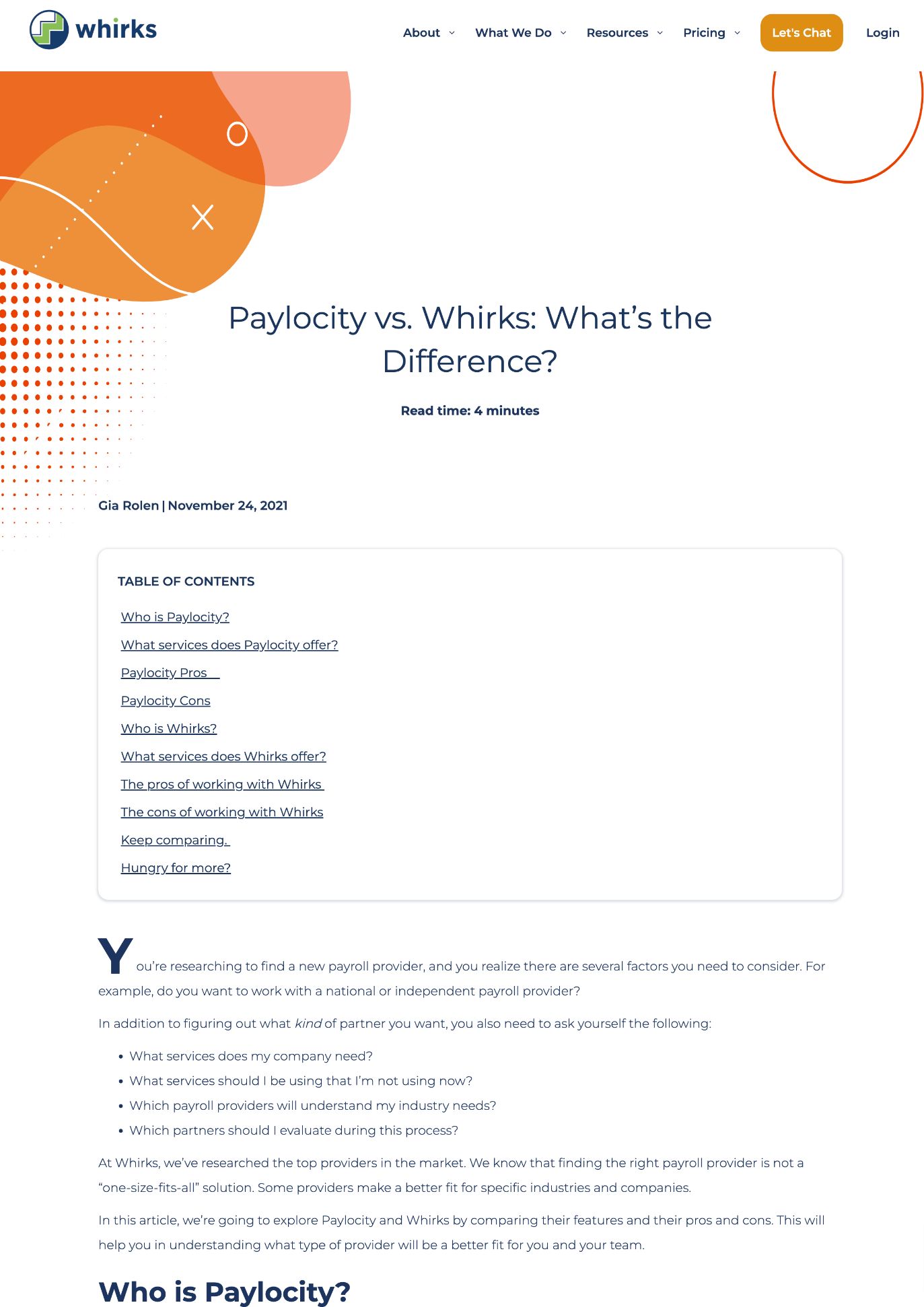
Here, IMPACT client Whirks combines the pros and cons approach with another approach we’ll discuss later — competitor comparison.
They use a table of contents to neatly organize a head-to-head comparison of their offering against competitor Paylocity starting with pros and cons.
Category comparison articles
Category comparison articles are similar to the pro and con articles, but instead of discussing the benefits and drawbacks of two products or services, you’re comparing similarities and differences by category or feature.
For example, instead of listing out the pros and cons of purchasing a glass and wood greenhouse versus metal and plastic, you would compare each feature head-to-head and discuss the similarities and differences.
This type of article is useful for prospects seeking a specific use or benefit and who will likely make a decision based on which performs best in that area.
8. Pricefx vs Vendavo? – Choose the Best Software for You — PriceFx
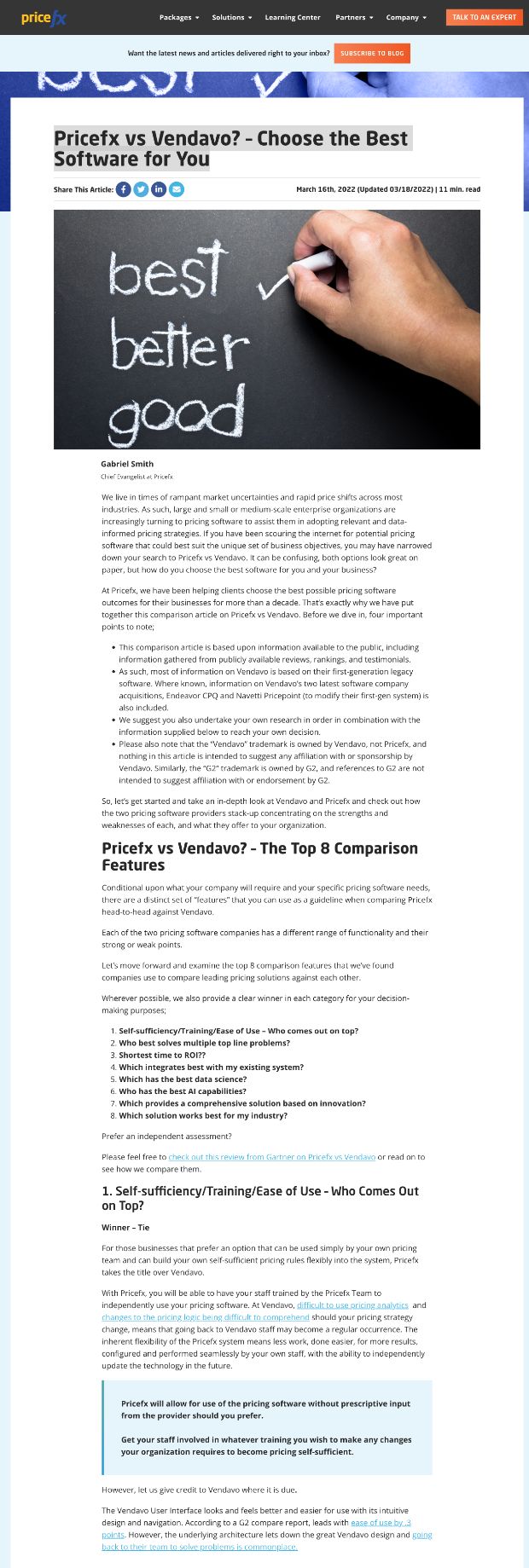
In this example, PriceFx, another IMPACT success story, compares itself against competitor Vendavo.
What’s unique and notable here is, rather than comparing features, it compares user problems or questions a prospect may ask in regards to the products:
- Self-sufficiency/Training/Ease of Use – Who comes out on top?
- Who best solves multiple top-line problems?
- Shortest time to ROI?
- Which integrates best with my existing system?
- Which has the best data science?
- Who has the best AI capabilities?
- Which provides a comprehensive solution based on innovation?
- Which solution works best for my industry?
This resonates deeper with the reader because it speaks directly to the questions they have in their mind. They don’t have to do the extra thinking about what a feature means for them.
9. Vinyl Liner Pools vs. Fiberglass Pools: An Honest Comparison — River Pools and Spas
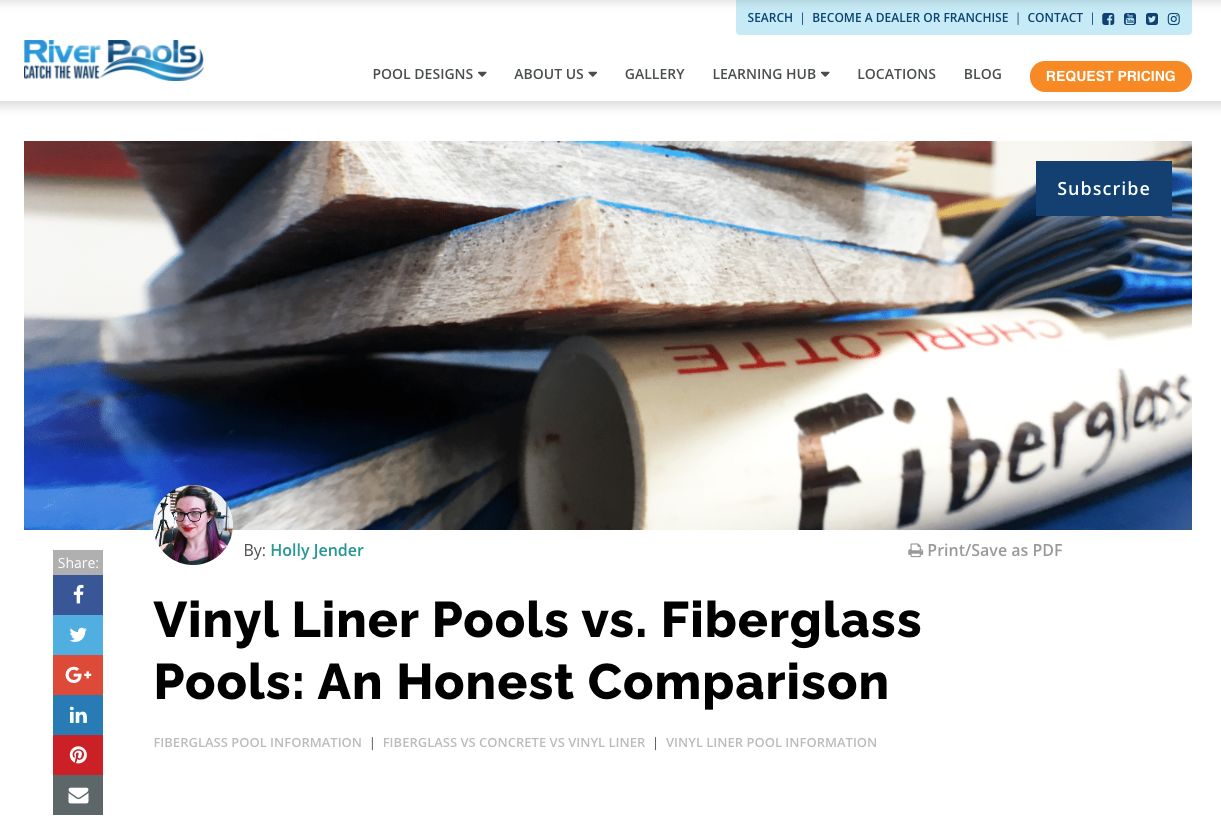
Which kind of pool works best for your needs?
The comparison categories in this article are whether or not the pool can be customized, how long it takes to install, cost up front and over time, etc. — cover every angle as honestly and thoroughly as possible.
What we like about this article:
- Short but clear descriptions about the differences
- A conclusion under each category lists the “winner”
- Lots of photos to illustrate the point
- An easy-to-scan chart summing up the article
The article concludes with a strong, related call-to-action that basically says if you’re interested in learning more, download a handy comparison guide.
This keeps people learning and engaged with the content, which search engines notice (and love!).
10. What is the Difference Between Metal Roofs and Asphalt Shingles? — S-5!
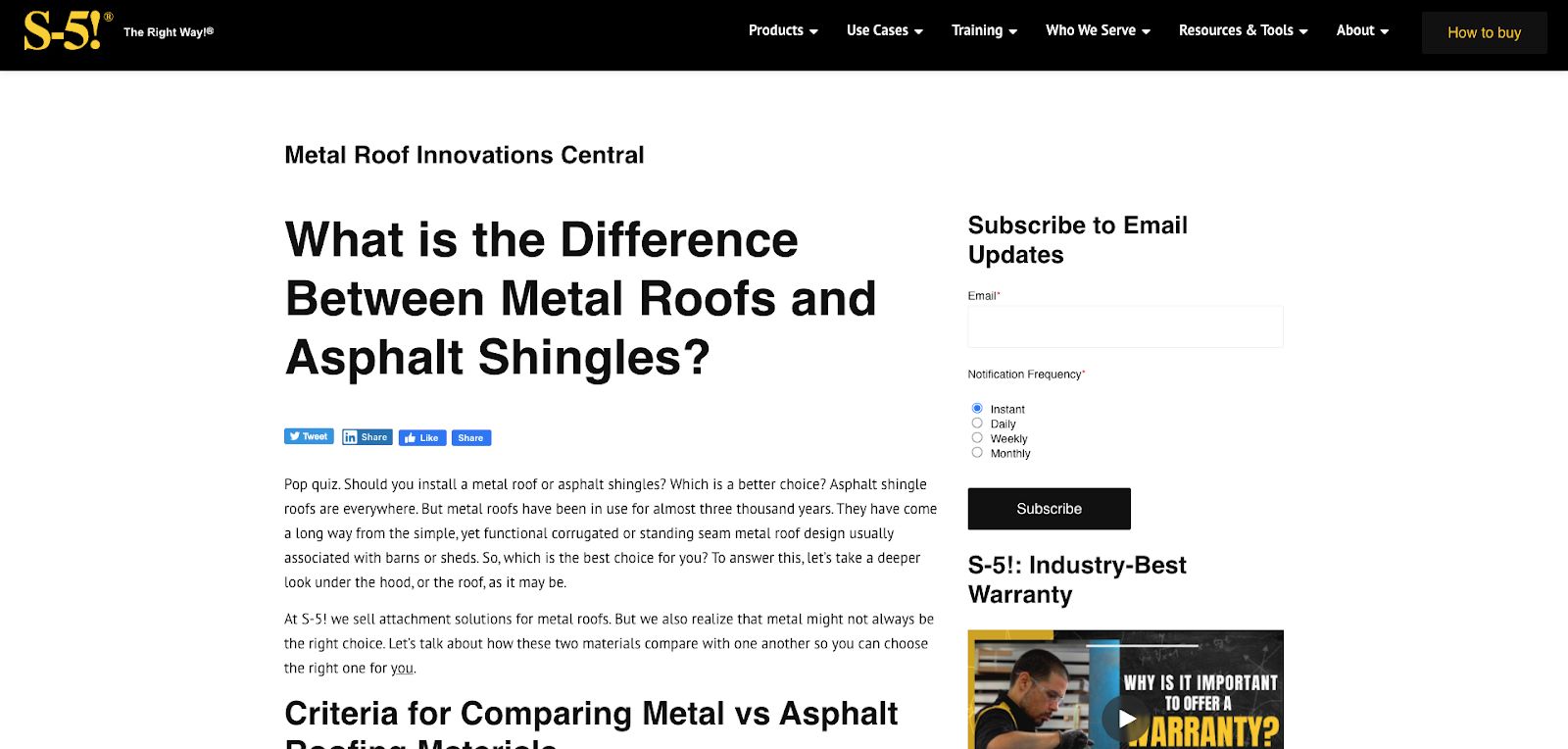
This is similar to the article by Sheffield Metals — also a metal roofing and manufacturing company — but instead of approaching it in a pro-and-con way, this IMPACT client uses the category angle.
Compare these two closely and see how they contain the same information but use a different framework to present it.
What we like about this article:
- Acknowledges metal roofing (which they sell) might not be the right choice for you
- Starts out with engaging figures and stats about the popularity of metal roofing
- Lists clearly from the start which categories they’ll be going over
- Includes a few well-placed CTAs midpage to further engage the reader
11. Comparing Truckload vs Intermodal: 11 Differences Shippers Should Know — InTek Freight & Logistics
As a freight and logistics company, InTek, an IMPACT client, wants to help businesses understand which types of shipping choices could be ideal for their particular hauls, bringing ease of choice for a company’s supply chain requirements.
What we like about this article:
- Starts with a list of categories covered, so you can quickly see if your question will be answered or if you’re in the right place
- Eleven comparison points
- Contains a few simple CTAs for downloading an information guide and for getting more information
- Has a list of benefits for going with a smaller freight company (like Intek) versus the big-name brands
12. Project Manager vs. Construction Manager: What’s the Difference? — Aquila Commercial
IMPACT client Aquila Commercial’s category comparison article is on the shorter side, but they make up for this in substance.
The first thing you see when on the page is a large image, clean text, and lots of white space, which can be a huge relief to readers (it’s easier on the eyes and draws their attention a bit better).
The article goes on to speak simply about a project manager versus construction manager role and why a company might need to hire both.
What we like about this article:
- Breaks down what each role does during different parts of the project process
- Ends with links to more relevant articles and a CTA to download a hiring guide
- Options to sign up for their newsletter, but in a way that isn’t too obtrusive
- Clean text and easy-to-read layout, including a handy infographic
13. Art School vs. Traditional College: Which One Is Right for Me? — Hussian College
Even colleges and other educational institutions can take advantage of comparison articles, as demonstrated by Hussian College, an art school in Philadelphia.
In this article, the school explains the difference between art and traditional colleges, using categories such as majors available, coursework, social components, and cost.
What we like about this article:
- Covers a range of categories, from education to social
- When discussing the type of education artists need, they’re honest about it, depending on the student
- They walk you through what you should consider when making your choice
- In the “about us” section, they offer themselves up as a consideration, not a definite solution
Competitor comparisons
Competitor-comparison articles can be the most difficult to wrap your head around. Many companies stop and say, “But why would I want to talk about my competitors? Won’t I be sending my customers away?”
But in reality, doing so will cause your customers to see you as honest and transparent. It shows them you value what’s best for them and often makes them feel grateful you’re trying to help, rather than hammer away at a hard sell.
With these examples, you’ll see the lists share competitors and talk about what they offer — in a positive light to maintain your company’s integrity.
14. La-Z-Boy vs Ashley Furniture: 7 Differences You Should Know in 2022 — La-Z-Boy
In this comparison article, IMPACT client La-Z-Boy takes on its biggest competitor: Ashley Furniture. Throughout the article, they compare things such as cost, quality, and shipping policies.
They are careful not to speak poorly about their competition, though some negatives are shared about the company, such as customer complaints about shipping issues and damaged goods.
If you take this approach, be sure to share only what is public and be backed up with facts.
What we like about this article:
- Starts with a video outlining the major differences between the two brands
- Doesn’t speak negatively about Ashley, but sticks to facts backed up in the article
- Offers additional resources at the end to keep the reader engaged (e.g., more articles, and a design consulting appointment sign-up)
15. GoDaddy vs. Mailchimp — Mailchimp
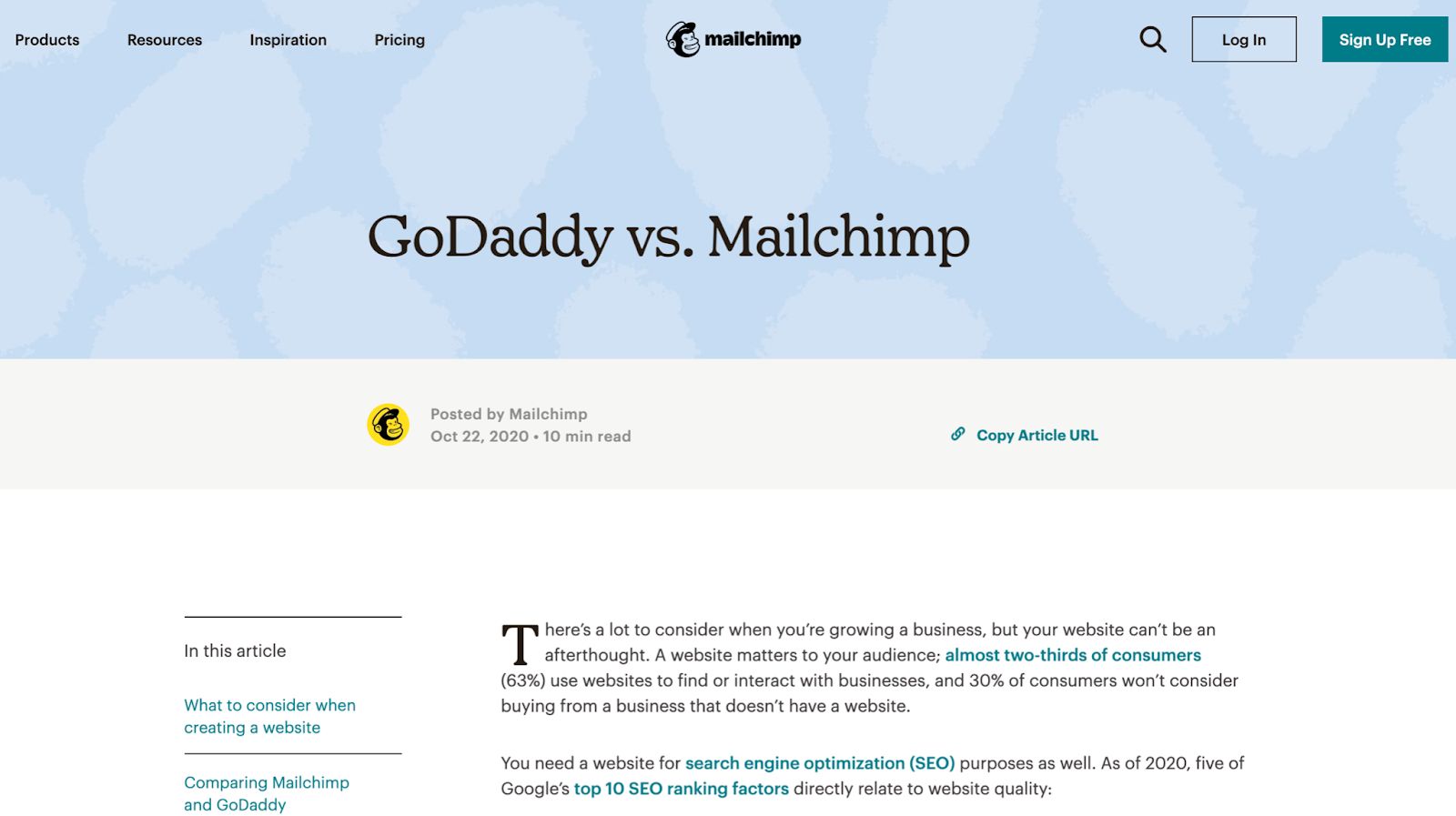
When comparing their web hosting services with GoDaddy (a prominent and well-established web hosting platform), Mailchimp covers every angle possible.
They discuss what you need to consider when building a website, the difference between the two companies’ services, and how to choose between the two.
Although Mailchimp does lean a bit heavy on a “we’re the better choice” mentality, they do explain that every service has its pluses and minuses, and it’s ultimately up to you to decide.
What we like about this article:
- It goes deep into the differences between the two web hosting services
- Mailchimp isn’t afraid to talk positively about their competitor or say they might be a better option
- There is an easy-to-navigate menu on the side, where you can jump to the topics you’d like to read
- There are more articles at the end if you’re interested in learning more about their services or different company comparisons
Comparison tools, pages, and more
Comparisons shouldn’t be limited to your blog articles.
Yes, these are likely the easiest to put together, but different mediums may be more effective and engaging at communicating the same information to your potential buyers.
16. Compare iPhone Models Interactive Tool — Apple

One of my favorite (and most helpful) comparison tools is this page from Apple. If you’re an iPhone user, every time a new model is released, you likely find yourself asking “how is this different from what I have?” Or “how does the Pro differ from the Max?”
Recognizing this, Apple created a handy page where you can compare up to three iPhone models. They start at design and price, then go all the way down to the materials used to build it, camera specs, battery life, and processors.
They leave no stone unturned and make it easy to find the information that matters to you most with headers like display, camera, and size and weight.
17. Salesforce vs HubSpot Page — HubSpot
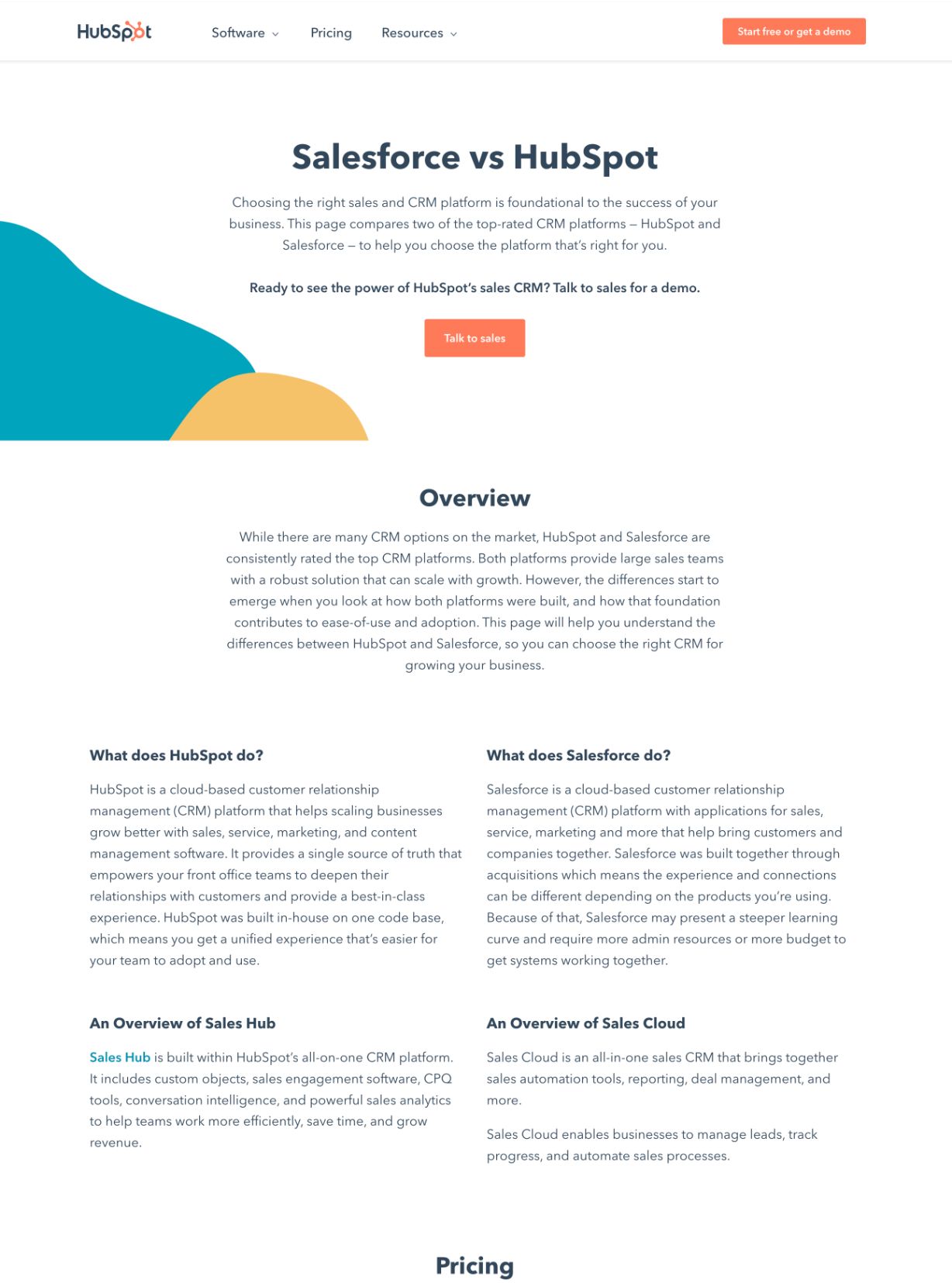
Early on, the HubSpot CRM was mired by comparisons to Salesforce. Rather than ignore them, HubSpot created a detailed and candid page on its website directly comparing itself against its competitor.
They talk about the differences and similarities and even any shortcomings HubSpot may have.
Overall, this does a beautiful job of guiding their customer to the right solution for them, even if it’s not HubSpot.
18. Webinar: Why choose Slack over Skype and Microsoft Teams? – Slack
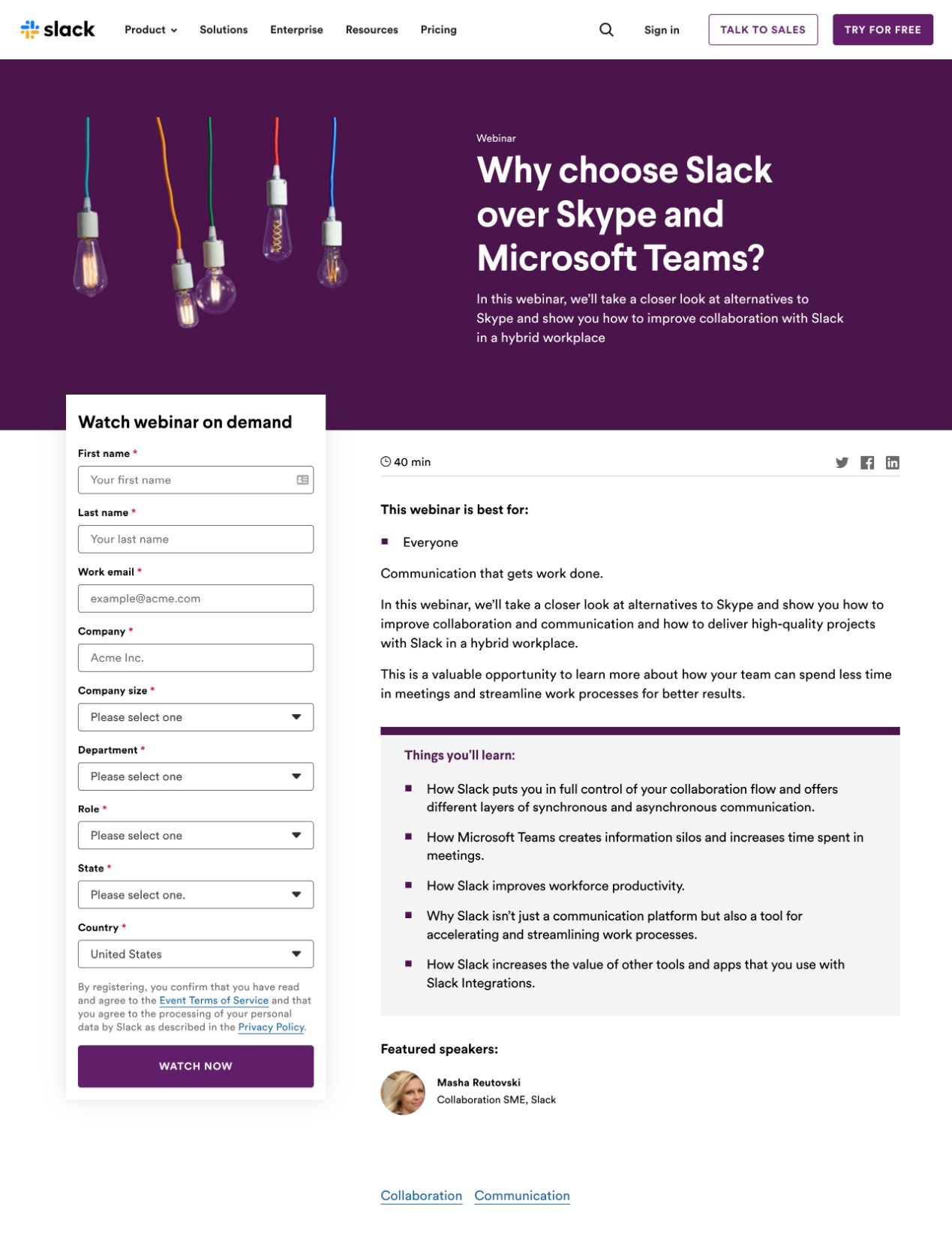
Making its second appearance on our list, Slack dedicates an entire website to comparing itself to competitors Skype and Microsoft Teams.
While we’d have recommended they be a little more neutral in the discussion of the tools here, this is a unique and engaging way to share comparison content with your audience and guide them towards the right choice for them.
After all, they know their potential customers want to know this information. And Slack would rather have people hear it from them than from Microsoft or another outlet.
Now, go write those comparison blog articles for your business!
Now that you’ve seen these great examples of comparison articles, we hope you find it easier to write your own.
Keep in mind we have a ton of digital sales and marketing courses, where you can learn even more about content creation.
Get started by checking out our free IMPACT+ course How to Write the Big 5 for more on comparison articles and the four other topic categories buyers can’t resist.

